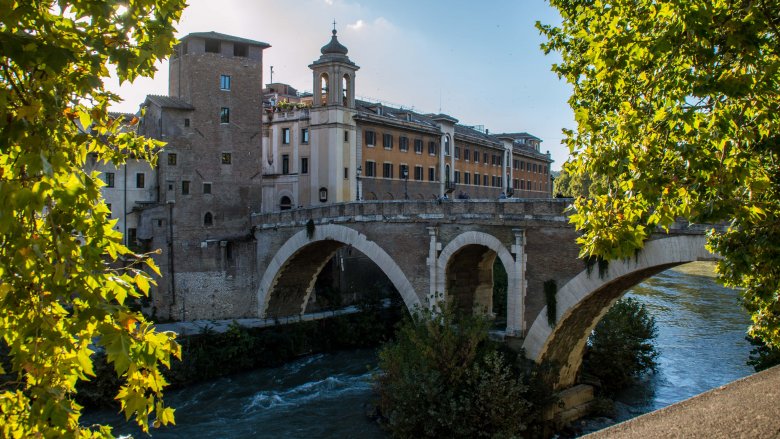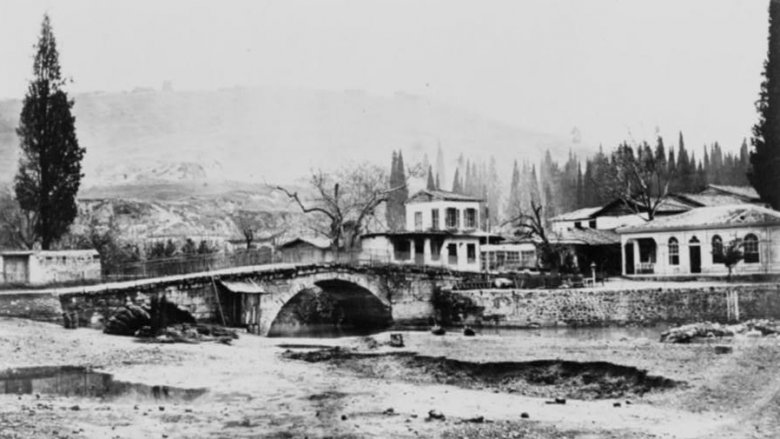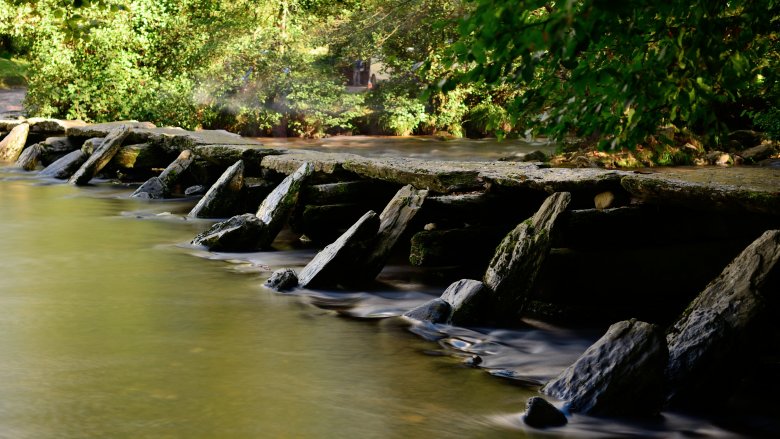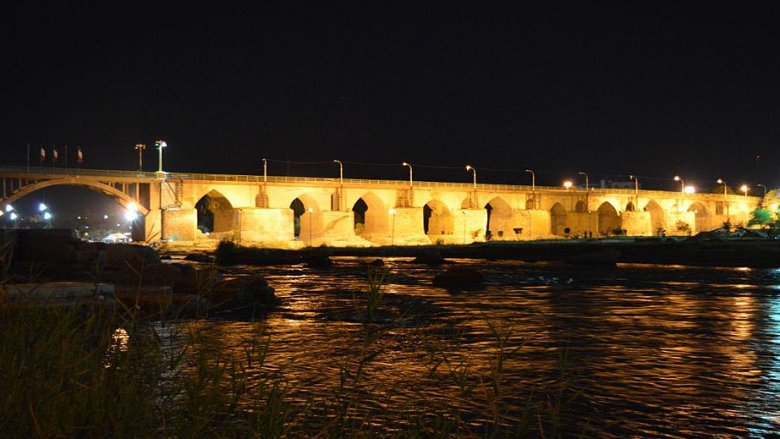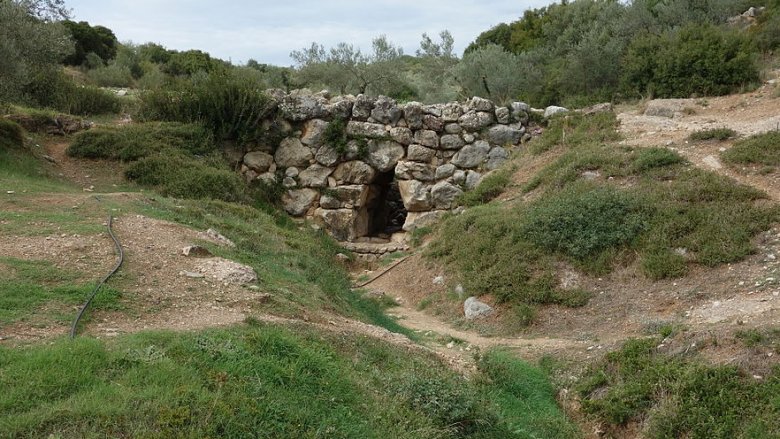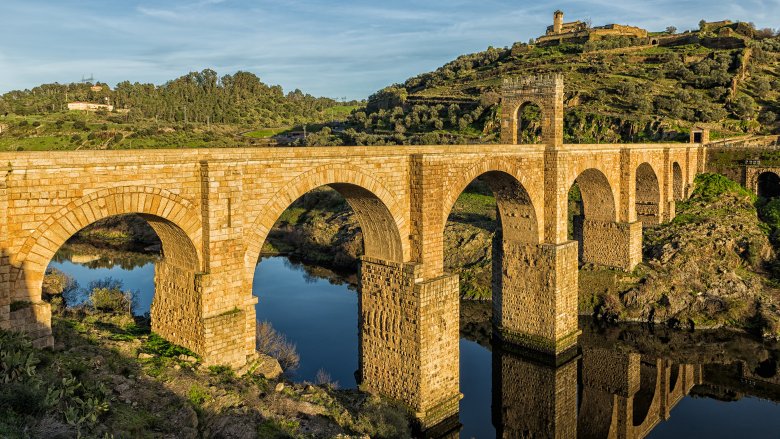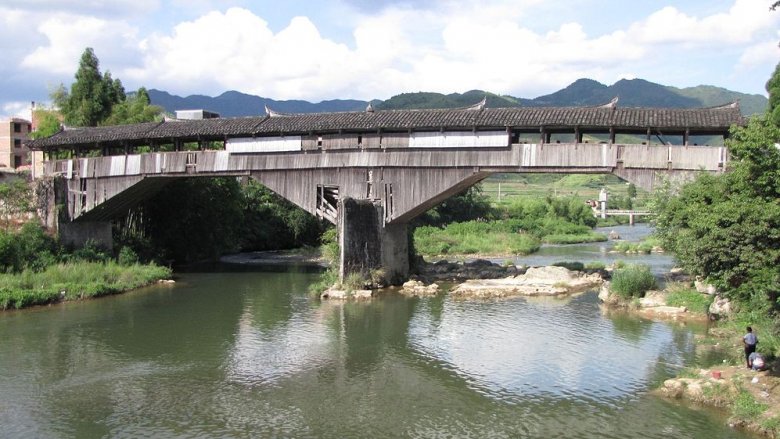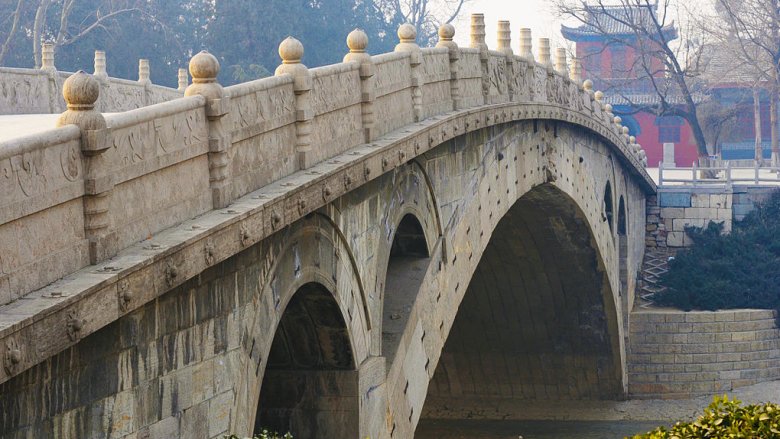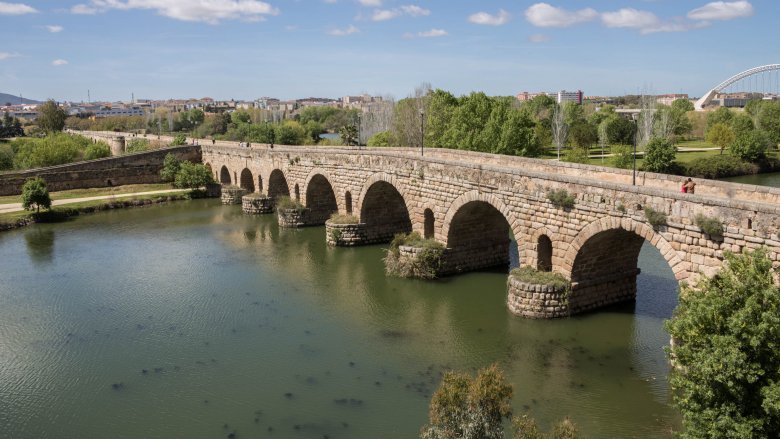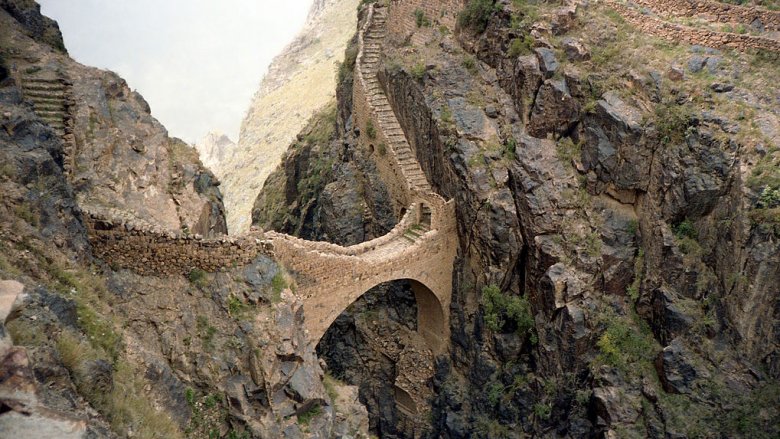Ancient Bridges Still In Use Today
When you think about bridges, you probably think about those technological wonders of the modern age, like the Golden Gate Bridge or whatever you cross on your way to work. It's easy to forget that the ancients built technological wonders, too — and they were doing it thousands of years before anyone ever conceived of building a bridge across the San Francisco Bay.
What makes ancient bridges even more amazing is that so many of them are not only still standing, they are also still in use. That means besides remaining structurally sound centuries after they were built, they can also withstand the daily onslaught of modern pedestrians and sometimes even automobiles. Yes, it's already pretty amazing that someone who lived a thousand years ago could design and build a structure capable of safely conducting people across rivers and canyons, but it's even more amazing that these ancient engineers knew how to make these ancient bridges last, too.
The oldest bridge in Rome
The Romans built a lot of bridges. In fact, when they got bored of sitting around the house watching the frescoes dry, the Romans would go out and build a bridge, just for a laugh. (Probably not really, but there are 931 Roman bridges still in existence in 26 countries, which means there were a fat lot of Roman bridges a couple thousand years ago.)
Anyway the oldest still-in-use bridge in Rome is the Pons Fabricius, which was built in 62 B.C. and according to Livius.org was likely a replacement for a wooden bridge that once crossed the same span. The bridge is just over 200 feet long, and it connects an island in the Tiber River with the opposite bank. (There was once a second bridge connecting the island to the opposite bank, but it was destroyed in the late 1800s.) Pons Fabricius is a pedestrian bridge, so unless a couple thousand pedestrians try to stand on it at the same time, there's a very good chance it will remain standing for at least another couple centuries.
The oldest bridge that hasn't collapsed under the weight of modern traffic (yet)
Pons Fabricius may be the oldest functioning bridge in Rome, but according to the Guiness Book of World Records, the oldest functioning bridge in the world crosses the river Meles in Izmir, Turkey. Built in 850 B.C., the bridge predates the Romans and is simply called Caravan, or Sarnic in Turkish. Its construction is slab-stone single-arch, and it's about 42 feet long. It's not super-impressive to look at — if you were a tourist in Izmir you'd probably entirely fail to notice it unless someone said to you, "Hey, this bridge is almost 3,000 years old."
According to CNN, Homer once crossed this bridge, and so did Saint Paul, though that's mostly legend since there weren't traffic cameras back then. Still, it's fun to imagine that Homer might have dreamed up a few lines for "The Odyssey" while taking in the view, so we'll let it slide.
Today this seriously elderly bridge is not only still standing and still in use but also has actual cars driving on it, which makes it not only a remarkable piece of ancient engineering but pretty terrifying if you're one of those drivers.
The devil's tanning booth
For some reason, the Guiness Book of World Records didn't count England's Tarr Steps as an actual bridge when it elected Caravan Bridge as the "oldest bridge still in use." According to Atlas Obscura, the Tarr Steps might predate the Caravan Bridge by a century or two, though it's impossible to say when exactly it was built since there isn't any record of its construction. Perhaps the missing date-time stamp is what kept it out of the record books.
The Tarr Steps, which crosses the River Barle in Exmoor National Park, is a "clapper bridge" — it's made of 17 flat stone slabs carefully arranged end to end and supported by stacks of smaller stones. Each of the flat slabs weighs up to 2 tons, so of course it was built by aliens. Not really, but it is hard to imagine how ancient people moved and arranged stones that big. So hard, in fact, that there's even a local legend that the devil built the bridge as a place to go sunbathing, which is patently ridiculous since everyone knows the sun never comes out in England.
Built by 70,000 Roman captives
This ancient bridge was commissioned in 260 A.D., so even though some people call it "the oldest usable bridge in the world," it's at least a century younger than the Caravan Bridge. It's considerably more impressive, though, with 14 original arcs (some have been replaced or reinforced) and 20 pedestals spanning 1,148 feet. According to Ancient Origins, Dezful Bridge is in modern-day Iran and was built by Roman prisoners of war after the Romans were defeated by the Sassanid King Shapur the First. Evidently, Shapur heard somewhere that the Romans were good at building bridges, so he put all 70,000 of his captives to work.
Unlike many of the still-standing Roman bridges, Dezful was built from brick instead of stone and was particularly vulnerable to flooding. Much of the structure has been repeatedly repaired over the centuries, and because of structural concerns, cars were recently prohibited from driving over it. Pedestrians are still permitted to cross the Dezful, though, and there is enough of the original structure still standing that it can claim to be one of today's oldest working bridges.
A carefully arranged pile of rubble
This very, very old structure is kind-of-sort-of a bridge, which probably explains why it isn't in the Guiness Book of World Records, even though Bridges of Dublin says it predates the Caravan Bridge by at least 1,000 years. The Arkadiko Bridge in Greece is basically a carefully arranged pile of rubble filling in a gully that is one of four known Mycenaean stone corbel arch bridges, built to make it easier for chariots to proceed unencumbered across the Grecian countryside.
Arkadiko is technically a stone arch bridge (the oldest surviving), but there's not much in the way of architecture to it. The bridge's builders simply filled the area around a culvert with large stones, leaving a relatively small hole to allow the water to pass underneath.
As it looks like a large pizza oven, this is another one of those bridges that you can't really appreciate without knowing something about its history. It's much more impressive when you know you're looking at something built thousands of years ago, even if you might be disappointed to learn that you can't actually bake an extra-large meat-lover's in it.
A bridge that might last forever
At the center of this bridge is a marble plaque bearing the words "Pontem perpetui mansurum in saecula," which means "I have built a bridge that will last forever." It sounds like an empty boast but here it is, almost 2,000 years later, and Caius Julius Lacer's Alcantara Bridge (Puente Trajan at Alcantara) is not only still standing, but is also in use by motor vehicles. According to the Bridges Database, the bridge, which crosses the Tagus River in Alcantara, Spain, was completed in 106 A.D., spans about 630 feet, and is around 230 feet tall.
Just like its designer said, Alcantara is a tough bridge — if it wasn't for all the wars, it probably would have survived to the modern era almost entirely unscathed. Unfortunately, humans have a long history of destroying things for fun and profit and arguing over things like whose crown is shinier and who's better at educating the population. In 1214 one of the arches was destroyed by the Moors in a skirmish. Then in 1760, the Spanish themselves destroyed one of the arches in hopes that it would prevent a Portuguese invasion. Then the same rebuilt arch was destroyed in 1809 during the War of Independence to slow down French troops. The bridge wasn't fully restored until 1890.
An 800-year-old wooden bridge held together with nothing but physics
All the bridges we've discussed so far are made of stone or brick, and there's a good reason for that — stone and brick are more likely to stand up to weather, war, and natural forces. So you might be surprised to hear that a wooden bridge made this list. It's not as old as the stone bridges, but any wooden structure that can survive for centuries really ought to get bonus points.
Qiancheng Bridge was built in Pingnan County in China during the Song Dynasty, between 1127 and 1279 A.D. It's an "arcade bridge," and it looks similar in structure to the old covered bridges that still cross the American landscape, although it's much, much older. According to China Daily, arcade bridges were built using an arch structure similar to their stone cousins, but what's really remarkable about them is they're built without nails. Instead, they get stability from an "inlaying of purlins and rafters." Which sounds pretty impressive until you realize that you actually have to walk across the thing and it's basically held together like an origami chicken.
Ancient wooden bridges, as you can probably guess, are subject to a lot more wear and tear than stone bridges, so they do have to be repaired or partially rebuilt from time to time. Still, there are plenty of stone bridges that didn't last as long as this one did, so it's hard not to be impressed.
The rainbow in the sky
China has some old stone bridges, too, although the oldest — Anji Bridge in Zhao County — is in such pristine shape that it looks like it could have been built a decade or two ago. This bridge has been impressing people for centuries — it's so old that you can read about it in ancient Chinese literature, where it's been described as a "rainbow in the sky" and as a "crescent moon rising from the clouds." At least one government official was so impressed by Anji Bridge that he recorded the name of the architect, which wasn't something dynastic officials did very often.
Li Chun completed Anji in 605 during the Sui Dynasty, and the bridge is still in use today. According to the American Society of Civil Engineers, Anji, which means "safe crossing," is China's oldest bridge and the world's oldest open-spandrel arch bridge — this type has a main arch that supports smaller arches on either end. It crosses 123 feet of the Jiaohe River and is about 24 feet above the water.
It's in remarkably good shape given its age and consistent usage — the only parts that "regularly" receive an upgrade are the posts and railings, which have to be replaced every few centuries.
The world's longest Roman bridge
Ah, the Romans. Conquering other humans and building bridges, but only in the strictest literal sense of the word. In the first century B.C., after establishing a colony in Augusta Emerita, in what is now Merida, Spain, they decided they needed a bridge to get across that pesky river.
According to Roamin' The Empire, the Guadiana River Bridge had to be long — nearly 2,600 feet — which makes it the longest existing Roman bridge in the world. The original builders had some pretty valid concerns about the might of the river, so they originally built the bridge in two sections, with a raised cutwater in between that could help divert the river. That lasted until the 17th century, when flooding damaged the cutwater and made it necessary to connect the two sections.
Like many ancient bridges, the Guadiana River Bridge has been repaired and rebuilt a number of times, so only some of it is original Roman, while the rest of it is of later construction. Still, engineers were apparently confident enough that they let cars drive over the bridge up until the late '90s, when they finally made it a pedestrian-only bridge.
A bridge made out of living roots
This is probably one of the youngest bridges on our list, but it hardly matters because it gets extra points just for being really, really cool. The Ummunoi Root Bridge is one of many similar bridges built in northeastern India several hundred years ago, according to Atlas Obscura. It differs from Roman bridges and the like in that its engineers knew spending hours breaking their backs by moving huge stones around was totally for suckers. So instead, these ancient geniuses simply wove tree roots together and tended them until they formed super-strong, living bridges over the many rivers that crisscross the region.
Now, you can't do this with just any tree, so don't think about trying to coax your fruitless mulberry into a root bridge because you can't do it. These bridges are made out of the roots of an Indian rubber tree, which has a couple of important characteristics — first, it has a very strong root system that lends itself to manipulation and can support a lot of weight. Second, it has secondary roots that sprout from its trunk higher than ground level, which is pretty convenient if you want to use those roots to cross a river.
No one knows exactly how old the root bridges are — some estimates say at least 500 years. The Ummunoi bridge, which has a span of about 56 feet, is thought to be one of the oldest.
A bridge that might fall apart if you look at it funny
High on the list of old bridges that are really cool but also really, really terrifying is the Shaharah bridge in Yemen. Shaharah was built in the 17th century, so it's not super old, at least not by ancient bridge standards, but it's still worth a mention because it crosses a 300-foot-deep gorge and looks like it would probably crumble under your feet if you jabbed it with your toe. That look is actually by design. According to Ancient Origins, the people who built the Shaharah were wary of invading forces, so they wanted a bridge strong enough for daily use but not too strong because they didn't want invading armies using it as a pathway into their neighborhood.
The Shaharah has a 65-foot span and people still use it today, even though it was literally designed to easily come apart if there was an army trying to cross it. At any rate, it looks pretty cool. From a safe distance. Maybe this is one of those "look but don't touch" tourist attractions.

